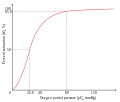Hemoglobin
Hemoglobin is a protein in red blood cells that carries oxygen from the lungs to the body's tissues and returns carbon dioxide from the tissues back to the lungs. Hemoglobin is made up of four protein molecules (globulin chains) that are connected together.
Structure[edit]
The hemoglobin molecule is a complex structure made up of four globulin chains, each of which is attached to a heme group. The heme group contains an iron atom, which is capable of binding to a molecule of oxygen. Each hemoglobin molecule can therefore carry four molecules of oxygen.
Function[edit]
The primary function of hemoglobin is to transport oxygen from the lungs to the tissues of the body, where it is used for cellular respiration. Hemoglobin also helps in the transport of carbon dioxide and hydrogen ions back to the lungs.
Hemoglobin levels[edit]
Normal hemoglobin levels can vary depending on the individual and the laboratory that analyzes the blood sample. However, typical values are:
- Men: 13.5 to 17.5 grams per deciliter (g/dL)
- Women: 12.0 to 15.5 g/dL
[edit]
There are several disorders related to hemoglobin, including:
- Anemia: A condition in which the body does not have enough healthy red blood cells to provide adequate oxygen to body tissues.
- Sickle cell disease: A genetic disorder that affects hemoglobin and can lead to various complications, including pain episodes, swelling of hands and feet, frequent infections, and vision problems.
- Thalassemia: A genetic blood disorder that causes the body to make fewer healthy red blood cells and less hemoglobin than normal.
Gallery[edit]
-
1GZX Haemoglobin
-
Max Perutz
-
Hemoglobin ABD Alignment
-
Heme B
-
Hemoglobin T-R State Animation
-
Hemoglobin Saturation Curve
-
Postnatal Genetics
-
Hemoglobin Test American Red Cross
-
Riftia Tube Worms Galapagos 2011
-
Heart of Steel (Hemoglobin)
See also[edit]
Ad. Transform your life with W8MD's Budget GLP-1 injections from $75


W8MD offers a medical weight loss program to lose weight in Philadelphia. Our physician-supervised medical weight loss provides:
- Weight loss injections in NYC (generic and brand names):
- Zepbound / Mounjaro, Wegovy / Ozempic, Saxenda
- Most insurances accepted or discounted self-pay rates. We will obtain insurance prior authorizations if needed.
- Generic GLP1 weight loss injections from $75 for the starting dose.
- Also offer prescription weight loss medications including Phentermine, Qsymia, Diethylpropion, Contrave etc.
NYC weight loss doctor appointmentsNYC weight loss doctor appointments
Start your NYC weight loss journey today at our NYC medical weight loss and Philadelphia medical weight loss clinics.
- Call 718-946-5500 to lose weight in NYC or for medical weight loss in Philadelphia 215-676-2334.
- Tags:NYC medical weight loss, Philadelphia lose weight Zepbound NYC, Budget GLP1 weight loss injections, Wegovy Philadelphia, Wegovy NYC, Philadelphia medical weight loss, Brookly weight loss and Wegovy NYC
|
WikiMD's Wellness Encyclopedia |
| Let Food Be Thy Medicine Medicine Thy Food - Hippocrates |
Medical Disclaimer: WikiMD is not a substitute for professional medical advice. The information on WikiMD is provided as an information resource only, may be incorrect, outdated or misleading, and is not to be used or relied on for any diagnostic or treatment purposes. Please consult your health care provider before making any healthcare decisions or for guidance about a specific medical condition. WikiMD expressly disclaims responsibility, and shall have no liability, for any damages, loss, injury, or liability whatsoever suffered as a result of your reliance on the information contained in this site. By visiting this site you agree to the foregoing terms and conditions, which may from time to time be changed or supplemented by WikiMD. If you do not agree to the foregoing terms and conditions, you should not enter or use this site. See full disclaimer.
Credits:Most images are courtesy of Wikimedia commons, and templates, categories Wikipedia, licensed under CC BY SA or similar.
Translate this page: - East Asian
中文,
日本,
한국어,
South Asian
हिन्दी,
தமிழ்,
తెలుగు,
Urdu,
ಕನ್ನಡ,
Southeast Asian
Indonesian,
Vietnamese,
Thai,
မြန်မာဘာသာ,
বাংলা
European
español,
Deutsch,
français,
Greek,
português do Brasil,
polski,
română,
русский,
Nederlands,
norsk,
svenska,
suomi,
Italian
Middle Eastern & African
عربى,
Turkish,
Persian,
Hebrew,
Afrikaans,
isiZulu,
Kiswahili,
Other
Bulgarian,
Hungarian,
Czech,
Swedish,
മലയാളം,
मराठी,
ਪੰਜਾਬੀ,
ગુજરાતી,
Portuguese,
Ukrainian












